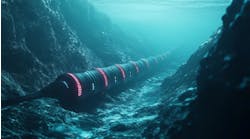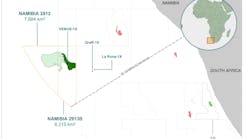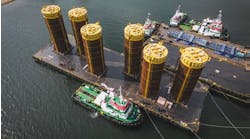David Paganie • Houston
Deepwater production
A number of deepwater wells have been opened up for first production in the Mississippi Canyon and Green Canyon areas in the Gulf of Mexico. ATP Oil & Gas has achieved first production from the Gomez field located across portions of Mississippi Canyon blocks 667, 668, and 711, in approximately 3,000 ft of water. The Gomez development comprises subsea wells tied back to the converted semisubmersible floating production facility,Rowan Midland, moored on MC 711.
At print, the semi was receiving flow from two subsea wells (No. 4 ST1 & No. 6) completed on the southern portion of MC 711, under phase 1 of the project.
The operator plans to begin a drilling program, under phase 2, in 3Q 2006 to exploit the northern portion of the Gomez project area, comprising MC 667 and 668. Diamond Offshore’s semiOcean Quest is contracted to undertake the phase 2 drilling program.
ATP operates Gomez with a 100% working interest. The field is estimated to contain a total of approximately 100 bcfe of proved, probable, and possible reserves.
• • •
Dominion E&P received first production from the Rigel and Seventeen Hands fields located in Mississippi Canyon blocks 296 and 299, respectively. Rigel is situated in approximately 5,200 ft of water and Seventeen Hands is in 5,800 ft of water.
Field development comprises one subsea well on MC 299 with tieback via approximately 21 mi of 8-in. flowline to the Rigel discovery well and subsea PLET in MC 252, with wellstream terminating at the existing Gemini subsea manifold in MC 292. From here, production flows to the Chevron-operated platform for processing in Viosca Knoll block 900. CalDive’s pipelay vesselIntrepid performed the flowline installation.
The combined design rate for Rigel and Seventeen Hands is 160 MMcf/d of gas. Dominion operates both fields and holds a 53% interest in Rigel and a 38% interest in Seventeen Hands.
• • •
Kerr-McGee Corp achieved first production from the Ticonderoga field located in Green Canyon block 768 in 5,250 ft of water. The field is produced through two subsea wells tied back to Kerr-McGee’s 100%-ownedConstitution spar installed on Green Canyon block 680 in 5,000 ft of water.
In February 2006, Kerr-McGee started production from two subsea wells on the Ticonderoga field through its Constitution spar located in approximately 5,000 ft of water on Green Canyon block 680.
Kerr-McGee operates Ticonderoga with a 50% working interest; Noble Energy Inc. owns the remaining 50% working interest.
Ticonderoga has estimated reserves in the range of 30-50 MMboe, and has reached peak production volumes of approximately 20,000 b/d of oil and 15 MMcf/d of natural gas.
TheConstitution truss spar is equipped with capacity to process 70,000 b/d of oil and 200 MMcf/d of natural gas
At print, Kerr-McGee was exploring the area about nine miles east ofConstitution with a well on the Caesar prospect in Green Canyon block 683 in 4,457 ft of water, with Noble’s semi, Noble Amos Runner. The operator plans to drill an additional exploration well in the Green Canyon area later this year.
Rig deal targets drilling records
Chevron has issued a trio of contract awards to Transocean for lease extensions and for construction of a new drillship capable of drilling down to 40,000 ft total vertical depth, in up to 12,000 ft of water. A rig built with this capacity could eclipse the current US GoM record for the deepest well drilled at 34,189 ft, and the world water-depth drilling record of 10,011 ft, both held by Transocean with Chevron as designated operator. Combined revenues generated from the three agreements could reach $1.7 billion over a 10.5-year timeframe, says Transocean.
Four deepwater fields were recently brought onstream: Gomez in Mississippi Canyon block 711 in 3,000 ft of water, Rigel in Mississippi Canyon block 296 in 5,200 ft of water, Seventeen Hands in Mississippi Canyon block 299 in 5,800 ft of water, and Ticonderoga in Green Canyon block 768 in 5,250 ft of water. Also illustrated is Kerr-McGee�s exploration well Caesar in Green Canyon block 683 in 4,457 ft of water.
The new DP-capable, double-hulled drillship,Discoverer Clear Leader, will undergo an approximate 30-month construction phase at Daewoo Shipbulding and Marine Engineering Yard Co. Ltd. in Okpo, South Korea. Total estimated capital expenditures of approximately $650 million are required for this phase.
“The rig will feature Transocean’s patented dual-activity drilling technology, allowing for parallel drilling operations designed to save time and money in deepwater well construction, compared to conventional rigs,” says Transocean. The drillship will also comeequipped with an enhanced top drive system, an expanded high-pressure mud-pump system, expanded completions capabilities, and a variable deckload of more than 20,000 metric tons.
Pending successful sea trials and client acceptance, the rig is scheduled to undertake a five-year commitment with Chevron in the GoM beginning in 2Q 2009.
Contract extensions
Chevron also awarded Transocean contract extensions for two of its drillings rigs currently committed to the operator. The operator exercised a final one-year option on the 5th generation drillship,DiscovererDeep Seas, which is expected to start in January 2008, following an estimated 20-day maintenance period. Concurrently, the company elected to extend the rig’s contract for an additional two years beginning in January 2009.
In addition, Chevron extended its contract for the 5th generation semi,Cajun Express, for an additional two years starting in July 2007, which is a direct continuation of the rig’s current commitment for the operator in the Gulf.
Transocean�s Enterprise-class drillship Discoverer Deep Seas currently holds the world water-depth drilling record of 10,011 ft from the Chevron-operated Toledo well in Alaminos Canyon block 951. The drilling contractor�s new endeavor, Discoverer Clear Leader, will be an enhanced version of its three predecessor Enterprise-class drillships, designed to drill in up to 12,000 ft of water. Photo courtesy of photographer, Ken Childress. Source: Transocean.
Transocean also secured a contract extension for its 5th generation drillship,Discoverer Enterprise. The three-year contract extension for BP is scheduled to start in December 2007, immediately following the rig’s current commitment for the operator in the GoM. Transocean says it anticipates revenues in the range of $569 million over the three-year term.
In other drilling news, Rowan won a two-year contract by a major oil and gas company to drill one or more ultra-deep wells.
Rowan has nominated its Super Gorilla-class jackup rig,Bob Palmer, for the drilling program, which is expected to begin in 1Q 2007. The drilling contractor estimates revenues from this contract in the range of $160 million to $170 million.
Danny McNease, Rowan chairman and CEO, says, “This contract reaffirms the market for drilling high pressure, high temperature wells deeper than 25,000 ft in the Gulf, and provides the highest day rate to-date for a jackup rig in the region.”
Acquisitions
Tetra Technologies Inc. recently executed a series of acquisitions to support its abandonment and decommissioning activities in the GoM. First, the company added two heavy-lift derrick barges to its existing fleet;DB-1 and Anna IV.
TheDB-1, equipped with a 615-ton crane and an eight-point, conventional mooring system, was purchased from Offshore Specialty Fabricators for $20 million. The barge is currently undergoing modifications and life-extension work, after which it is scheduled to join the contractor’s active fleet by June 1.
Tetra also chartered the derrick barge,Anna IV, on a long-term basis. At print, the vessel was under tow from Schiedarn, the Netherlands.
According to Geoffrey Hertel, Tetra’s president and CEO, the contractor is expanding its heavy-lift fleet to meet an increase in demand for well abandonment and decommissioning services in the Gulf primarily due to leftover work deferred from property sales in 2003 and 2004, damage from hurricanes Katrina and Rita, and companies’ preparations to soften the impact from future storms and rising insurance costs.
Tetra then acquired the assets and business of Epic Divers Inc. for $50 million in cash. Founded in 1972, Epic offers commercial diving services and operates a fleet of marine vessels, including saturation diving units capable of operating in up to 1,000 ft of water. Hertel says this acquisition will strengthen its well abandonment and decommissioning presence in the GoM.
• • •
Horizon Offshore added to its construction fleet through acquisition of theTexas Horizon(prev.Sea Wrangler) from Louisiana Pipelaying I, LLC for $23 million. The company intends to use the vessel in support of its operations in the US and Mexican sectors of the GoM. At print, the vessel was performing sea trials in preparation for upcoming work.
• • •
GoM leases continue to change hands as well. Marubeni Offshore Production USA Inc. entered into a purchase and sale agreement with Pioneer Natural Resources USA Inc. for acquisition of deepwater assets for $1.3 billion in cash. Marubeni gains interest in three producing projects: Falcon Corridor, Devils Tower, and Canyon Express; two potential developments: Ozona Deep and Thunder Hawk; and 88 exploration blocks.
Pioneer, however, will retain its 55% operator interest in Green Canyon block 299 and 300 where it drilled the Clipper discovery. Pioneer has contracted a rig to conduct appraisal drilling on the discovery in 2Q 2006, and is currently evaluating possible development scenarios.
• • •
Energy Partners Ltd. finalized an agreement to acquire a 25% working interest in 23 undeveloped deepwater leases from Noble Energy Inc. The agreement calls for a minimum of two exploration wells in 2006, including the Redrock prospect in Mississippi Canyon block 204 in 3,400 ft of water.
• • •
The Houston Exploration Co. signed a purchase and sale agreement to divest of the Texas portion of its GoM assets to “certain partnerships affiliated with Merit Energy Co.,” according to federal documentation, for $220 million in cash. The transaction is effective as of January 1. At the end of 2005, the divested assets had estimated proved reserves of 58.5 bcfe of natural gas.
MMS seeks input
The MMS and Bureau of Land Management (BLM) is seeking public input related to two proposed regulations: one would provide economic incentives to companies that produce natural gas from gas hydrates on the OCS and federal lands in Alaska, and the second regulatory initiative would provide economic incentives as well to companies that inject carbon dioxide and other appropriate gasses into oil and gas fields under federal management.
According to the MMS, the two advanced notices of proposed rulemaking are based on direction from Congress, as set forth in the National Energy Policy Act of 2005. Sections 353 and 354 of this law seek to promote domestic energy production by offering royalty relief to companies that produce natural gas from gas hydrates or use carbon dioxide or other gas-injection techniques to enhance oil and gas recovery, adds the agency.
The MMS is also seeking response to guidelines it submitted to states under the Coastal Impact Assistance Program (CIAP). Established under section 384 of the Energy Policy Act, the Secretary of the Interior is authorized to distribute $250 million annually to Alaska, California, Texas, Louisiana, Mississippi, and Alabama in fiscal years 2007 through 2010. According to the MMS, the funds will be allocated to each producing state and eligible coastal subdivision based on allocation formulas outlined in the federal documentation. Final guidelines are expected to be made available by the end of the year.•






